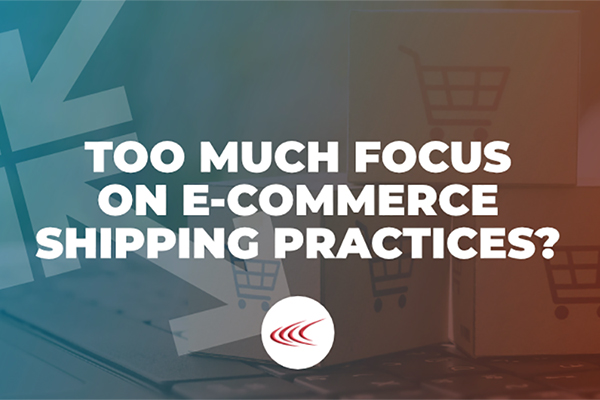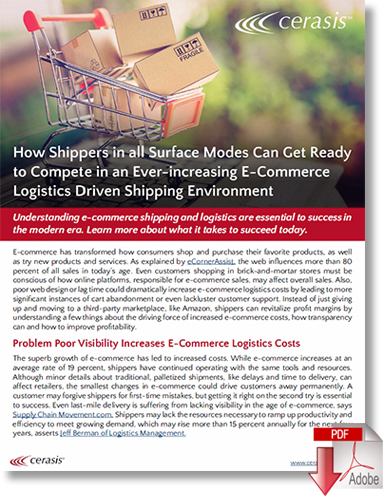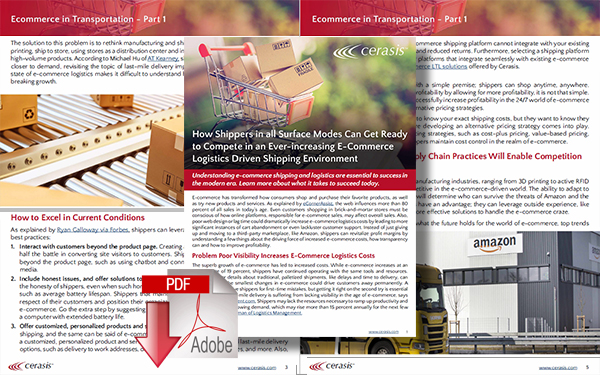Focusing Too Much on Ecommerce Shipping Practices? A Reminder Logistics Fundamentals Still Matter

The best ecommerce shipping practices rely on a strong logistics foundation, including the technologies that have propelled logistics into an era of unprecedented efficiency and cost-effectivity.
Ecommerce Growth Has Become Part of the Record Books
According to Eric Rice's article on Supply Chain 24/7, ecommerce growth in 2017 grew faster than it has since 2011, growing 49 percent, moving from 10 percent of total retail sales to 13 percent.
Unfortunately, ecommerce shipping practices, although different from traditional retail shipping, still fall short.
Supply chain leaders need to understand why logistics fundamentals will continue to shape ecommerce shipping strategy.
What’s Wrong With Ecommerce Shipping Practices?
The majority of distribution centers have enacted small process changes to handle increased demand due to ecommerce.
Minor improvements in the warehouse management system can help fulfill more orders, but the entire process will fail without a focus on the transportation strategy.
In other words, filling more orders is great, but it still requires significant use of logistics resources. Since 80 percent of distribution centers operate on manual processes, lost opportunities become a major issue.
Think about it; customers want the best deal, so how can a company offer the best deal without taking advantage of the lowest logistics costs?
In addition, ecommerce shipping practices must consider labor management, specifically loading and unloading, as well as yard management.
What every step in the supply chain before an order leaves on a truck is an opportunity for lost revenue.
Developing a robust ecommerce shipping strategy must still rely on the traditional use of shipping practices, ranging from intermodal shipping to LTL and beyond.
Ecommerce Shipping Practices Require Logistics Fundamentals
The best way to meet the rising demand of ecommerce is to ensure optimum use of transportation resources.
Transportation resources include the use of all available modes and existing physical locations, such as distribution centers, brick-and-mortar stores, and pickup centers.
Even Amazon has gotten in on the challenge with the creation of Prime Pickup locations. That’s the key phrase. Amazon, an ecommerce behemoth, has built multiple locations to take advantage of brick-and-mortar benefits.
However, the key lies in getting customers interested in visiting the location. As explained by Disney Investment Group, this includes selecting a location that has a necessity-based anchor, like a grocery store.
In terms of shipping strategy, it is about making sure customers have access to the easiest and most convenient means of receiving a product. Since ecommerce demand is increasing, the ability to use existing physical resources and locations to meet demand will define ecommerce shipping strategies.
For shippers, this may require the integration of platforms and continued shipments of products to brick-and-mortar locations. As with over-the-road transportation modes, taking advantage of resources, like a transportation management system (TMS), freight consolidation programs and value-added services, such as invoice auditing, can keep freight spend in check. The same concept applies to ecommerce shipping practices.
Best Ecommerce Shipping Practices in Using Traditional Logistics
- Digitize your fulfillment centers. Integration with the TMS can go a long way in reducing inaccuracies in freight quotes, helping your organization get the best deal and keep costs under control. The same level of technology can be integrated with existing ecommerce platforms to further refine the process. In fact, Cerasis now offers ecommerce LTL solutions for this purpose.
- Choose grocery-anchored locations for physical pickup points. As explained by Brad Thomas of Forbes, landlords have taken note of the demand for grocery-anchored spaces. Therefore, understanding the value of a location and how a company can leverage it to manage logistics spend is key to maintaining a competitive advantage in the age of ecommerce.
- Take advantage of existing storefronts. Brick-and-mortar stores can be used for pickup centers and as a distribution center. Since retailers face greater pressure to reduce inventory carrying costs, which enables competition with Amazon, using storefronts-as-a-distribution center can help mitigate added costs. Of course, this action goes back to ensuring cost-savings in traditional logistics, getting products from your actual distribution center to your brick-and-mortar location.
- Upgrade your facilities, and automate facilities management. According to QSI Facilities, automating facilities management practices effectively reduces facilities spend. Although it seems useless in transportation management conversations, it actually implies the ability to save money, reducing pricing for consumers. Savings could be used for investment in a TMS, integration of controls to enable pre-paid shipping for consumers and more. Furthermore, the aesthetic of your facilities are essential to attracting customers, and since the ecommerce experience defines omnichannel experiences, retailers must keep an eye on the state of the facility, explains Bob Kraemer of Chain Store Age.
- Leverage freight consolidation programs. Freight consolidation is a great way to develop an ecommerce shipping strategy that uses traditional logistics practices to save money. Freight consolidation enables shippers to combine smaller shipments into larger ones, which result in lower long-haul expenses. Of course, freight consolidation may not always be appropriate, especially for consumers paying a premium for faster shipping. As a result, it is important for shippers to continue using intermodal shipping options to meet the customers’ needs.
- Get end-to-end visibility into freight costs and status. End-to-end visibility is essential to successful logistics management, and with the rise of the Internet of Things and connected technologies, shippers can gain the end-to-end visibility necessary to ensure real-time access to shipment location, estimated delivery schedules, and customer transparency. In other words, end-to-end visibility enables automated delivery notifications, ability to change route status to avoid issues and better overall customer service levels.
Conclusion
The best ecommerce shipping practices rely on a strong logistics foundation, including the technologies that have propelled logistics into an era of unprecedented efficiency and cost-effectivity. Instead of risking ecommerce success with haphazard ecommerce shipping practices, shippers should continue to use both traditional and innovative best practices to manage logistics and get more product to consumers within the Holy Trinity of Shipping.
Related Ecommerce Continues to Focus on Omnichannel Supply Chain Strategies: Demands Continuous Improvement
Related White Paper
How Shippers Can Compete in an Ecommerce Logistics Driven Shipping Environment
Understanding ecommerce shipping and logistics are essential to success in the modern era, this white paper details what it takes for shippers in all surface modes to compete and succeed today. Download Now!
Article Topics
Cerasis News & Resources
GlobalTranz Appoints Executive Chairman Bob Farrell as Chief Executive Officer Amazon’s Drone Delivery Hits Milestone with Federal Aviation Administration Clearance Digital Supply Chain: The Landscape, Trends, Types, and the Application in Supply Chain Management Walmart’s Bid for TikTok Could Benefit the Retail Giant’s Ecommerce and Advertising Businesses The State of Ecommerce Logistics Heading into 2020 Peak Delivery Season Bringing Omnichannel to the Forefront of Ecommerce FedEx’s Fred Smith Optimistic About Economic Recovery as Ecommerce Business Booms More CerasisLatest in Transportation
FedEx Announces Plans to Shut Down Four Facilities The Two Most Important Factors in Last-Mile Delivery Most Companies Unprepared For Supply Chain Emergency Baltimore Bridge Collapse: Impact on Freight Navigating Amazon Logistics’ Growth Shakes Up Shipping Industry in 2023 Nissan Channels Tesla With Its Latest Manufacturing Process Why are Diesel Prices Climbing Back Over $4 a Gallon? More Transportation















